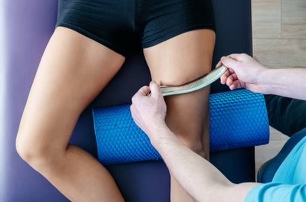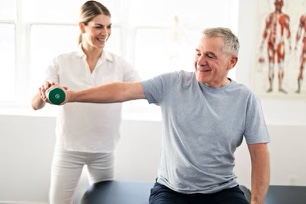About
Rubikon
We Redefine Rehabilitation and Athletic Training
Rubikon is redefining physical therapy and performance coaching by offering treatments and techniques, typically reserved for elite athletes—and making them now available to everyone. Whether you’re recovering from an injury, managing chronic pain, or pushing your physical limits, we are committed to helping you reach your full potential.
Meet the Founder

Dr. John P. White, a graduate of the University of the Incarnate Word and an Osteopractic Fellowship-trained clinician, is the visionary behind Rubikon. A hybrid athlete himself, John’s passion for combining elite-level care with accessible therapy took shape during his own journey through Mechanical Engineering and Psychology as an undergrad.
While undergoing ACL reconstructive surgery and rehab, he became frustrated with the quick-to-operate mentality of many surgeons and the passive acceptance of this approach by physical therapists. Recognizing the need for a better way, John sought to challenge the status quo. His dissatisfaction fueled a drive to explore more conservative, effective treatment methods.
After completing his physical therapy education, John immersed himself in mentorship and fellowship programs with top physical therapists at national champion Division 1 programs, professional sports teams, and even Olympic teams. Through these experiences, he mastered cutting-edge techniques proven to get athletes back on the field faster than traditional methods.
John’s vision for Rubikon is simple: to bring the same high-level, science-driven treatments typically reserved for elite athletes to everyone—regardless of their sport, fitness level, or background. With Rubikon, John is fulfilling his mission to ensure that the general public can experience the same rapid recovery and peak performance solutions once reserved for the few.
Our Services

Dry needling involves inserting fine needles into myofascial trigger points to release muscle tension and promote healing. The American Academy of Manipulative Therapy (AAMT) has found that dry needling can effectively reduce pain and improve function in both athletes and sedentary individuals. This technique works by disrupting dysfunctional muscle fibers and stimulating the release of endogenous opioids, which are natural painkillers. Research published in the Journal of Orthopaedic & Sports Physical Therapy shows significant improvements in range of motion and pain relief, making it an essential tool for both rehabilitation and performance enhancement .

Electrical stimulation (e-stim) uses electrical impulses to induce muscle contractions, enhancing recovery and muscle function. According to AAMT, e-stim can be particularly beneficial for athletes by promoting muscle hypertrophy and strength gains. For sedentary populations, it aids in managing chronic pain and improving muscle tone. Studies in Physical Therapy in Sport indicate that e-stim enhances blood flow, reduces inflammation, and accelerates tissue repair by promoting cellular activity and collagen synthesis .

Spinal manipulation involves manual adjustments to the vertebrae to restore joint function and alleviate pain. Research from AAMT indicates that spinal manipulation can improve spinal mobility, reduce back pain, and enhance overall physical performance. This technique also influences the central nervous system by modulating pain pathways and improving neuroplasticity. Studies in the Journal of Manipulative and Physiological Therapeutics have documented significant benefits for both athletes and sedentary individuals, including reduced pain and improved range of motion .

Extremity manipulation targets joints in the arms and legs to improve function and alleviate pain. The AAMT supports its use for athletes to manage injuries and optimize joint performance, and for sedentary individuals to treat conditions like arthritis and tendinitis. Research in the Journal of Orthopaedic & Sports Physical Therapy shows that extremity adjustments can restore joint mechanics, reduce inflammation, and improve range of motion, contributing to better functional outcomes and pain relief .

Cupping therapy involves placing cups on the skin to create suction, which improves blood flow and promotes healing. Studies in the Journal of Traditional and Complementary Medicine have found that cupping can reduce pain, improve circulation, and accelerate tissue repair by increasing local blood flow and reducing tissue hypoxia. This therapy helps athletes recover faster and reduces muscle soreness, while sedentary individuals benefit from pain relief and improved function in chronic conditions .

Myofascial release is a manual therapy targeting the fascia, the connective tissue surrounding muscles. This technique helps reduce pain and improve mobility by releasing fascial restrictions. Research published in Manual Therapy supports its effectiveness in treating conditions like plantar fasciitis, lower back pain, and fibromyalgia. Athletes use it to enhance flexibility and prevent injuries, while sedentary individuals benefit from reduced pain and improved function .

Concussion screening and education involve assessing individuals for concussion symptoms and providing information on managing and preventing concussions. This service is crucial for athletes, helping in early detection and proper management to reduce the risk of long-term damage. Educational programs raise awareness about concussion risks and promote safe practices in sports. Research from the Journal of Neurosurgery emphasizes the importance of timely concussion management and comprehensive education programs .

Individual performance coaching offers personalized training programs tailored to an athlete’s specific needs and goals. This approach optimizes performance through targeted exercises, nutrition guidance, and recovery strategies. Research in Sports Medicine shows that personalized coaching significantly improves athletic performance and reduces injury risks by addressing specific biomechanical and physiological needs .

Group performance coaching provides a collaborative training environment where athletes benefit from shared experiences and peer support. This approach fosters motivation and accountability, leading to improved performance. Group sessions include team-building activities and sport-specific drills that enhance overall athletic ability. Studies in The Journal of Strength and Conditioning Research highlight the benefits of group training in enhancing performance and adherence to training programs (Symmetry Physical Therapy (https://symmetryptmiami.com/meet-our-team/)) (Spinal Manipulation Institute (https://spinalmanipulation.org/2018/05/30/dry-needling-in-patients-with-multiple-sclerosis-neurophysiological-changes-pain-management/)) .

Vert Code is a specialized training program aimed at maximizing vertical leap. It combines strength training, plyometrics, and acceleration drills to improve jump height. Research in The Journal of Strength and Conditioning Research shows that targeted exercises can significantly enhance vertical leap performance by improving base strength and power .

Run Code focuses on improving running economy, form, and speed. This program includes biomechanical assessments, technique drills, and strength training to enhance running performance and prevent injuries. Studies in the International Journal of Sports Medicine indicate that tailored running programs lead to better running efficiency and reduced injury rates .

Maintenance programs for osteoarthritis aim to improve joint mobility, reduce pain, and prevent unnecessary surgery. These programs include low-impact exercises, strength training, and manual therapies. Research in Arthritis Care & Research shows that regular physical activity and targeted interventions can significantly enhance the quality of life for individuals with osteoarthritis by reducing pain and improving joint function

Blood flow restriction (BFR) training involves using cuffs to partially restrict blood flow during exercise. This technique increases muscle hypertrophy and strength by elevating growth hormone and anabolic signaling pathways. Research indicates that BFR is effective for pre and post-surgery rehabilitation, maintaining muscle mass, and speeding up recovery. Studies published in Sports Medicine and the Journal of Applied Physiology highlight BFR’s ability to induce significant muscle growth and strength gains with lower intensity exercise, making it ideal for injury prevention and recovery